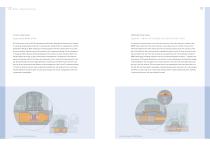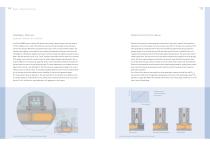Catalog excerpts

Product Overview info@burkert.com www.burkert.com Bürkert Fluid Control Systems Christian-Bürkert-Straße 13 -17 74653 Ingelfingen Germany Mass Flow Controllers for Gases
Open the catalog to page 1
Bürkert | Mass Flow Controller Introduction The term “gas” has its origin in the Greek word for chaos. Coincidence? Probably not! Gases are peculiar. They are volatile, sometimes reactive, and always expansive. This means that gases have very special handling requirements. Process gases are indispensable in industrial manufacturing. From coating and hardening surfaces, right through to the fermentation processes used in the pharmaceutical world. Inert gases are used for example to protect packaged foodstuffs against the effect of atmospheric oxygen and in metal processing to prevent the...
Open the catalog to page 2
Fascination Bürkert Welcome to the Fascinating World of Fluid Control Systems Bürkert Product Program Measurement and control: When it comes to working with liquids and gases, we are at your side − as a manufacturer of We are one of the few suppliers on the market to cover the complete control loop. Our current product range sophisticated products, as a problem-solver with an eye for the big picture, and as a partner offering you reliable advice. extends from solenoid valves through process and analytical valves to pneumatic actuators and sensors. Since we started in 1946, we have developed...
Open the catalog to page 3
Bürkert | Mass Flow Controller & Mass Flow Meter Product Overview All Mass Flow Controller (MFC)/Meter (MFM) work at a nominal voltage of 24V DC, have a low pressure drop and do not require flow conditioning at the inlet or outlet. Full scale ranges (273.15 K, 1013.25 mbar) Sensor technology Inline Sensor Body material Stainless steel, aluminium Neutral, non-contaminated gases Turn-down ratio Capillary Sensor MEMS Sensor Stainless steel Stainless steel, aluminium Stainless steel Stainless steel, aluminium Aggressive, toxic gases Neutral, non-contaminated gases Settling time Protection class...
Open the catalog to page 4
Bürkert | Mass Flow Controller & Mass Flow Meter Product Overview All Mass Flow Controller (MFC)/Meter (MFM) work at a nominal voltage of 24V DC, have a low pressure drop and do not require flow conditioning at the inlet or outlet. Type Full scale ranges (273.15 K, 1013.25 mbar) Sensor technology 8746 (MFC / MFM)1 20 - 1500 lN / min (N2), MFM up to 2500 lN/min (N2) Inline Sensor Body material Media 1:50 - Fieldbus gateway module (Type ME23) - nput and output modules of proprietary büS (Type ME29) I - Backplane module (Type BEF1) SCU add-ons: I/O modules (Type ME24) - I / O modules 4AO -...
Open the catalog to page 5
Bürkert | Measuring Principle The Measuring Principle of Thermal Mass Flow Mass Flow Controllers − Setup and Functioning The physical law is well known – heat always flows towards lower temperatures. So if a body has All Mass Flow Controllers from Bürkert are compact devices that control the mass flow of gases. a higher temperature than its environment, it will give off its heat energy to the neighbouring mass. They control a preset flow rate reference value – regardless of disturbance variables such as pres- So our thermal/calorimetric measurement technique utilises this principle, i. e....
Open the catalog to page 6
Bürkert | Setup and Functioning Inline Sensor MEMS Sensor The Inline sensor works in the CTA operating mode (Constant Temperature Anemometer), whereby In contrast to the Inline sensor, with which the mass flow in the main channel is measured, the an electrical heating resistance (RS) and a measurement resistance (RT) are regulated at a constant MEMS sensor determines the values directly in a secondary channel. In detail: A laminar flow temperature difference. Both resistances are directly placed in the flow channel; three more resist- element brought into the main channel ensures the...
Open the catalog to page 7
Bürkert | Setup and Functioning Capillary Sensor Solenoid Control Valve Types 8710/8700, 8715/8705 As with the MEMS sensor, a laminar flow element also causes a pressure drop in the main channel Solenoid control valves are electromagnetic control valves. They open to specific stroke positions – with the capillary sensor. A part of the total flow rate flows through a parallel running secondary depending on the control signal. Two forces counter one another in the valve: one a spring, and the channel. The decisive differences: the capillary sensor has no direct contact with the medium. The...
Open the catalog to page 8
Bürkert | Mass Flow Controllers Digital Control Electronics The sensor’s measuring signal range is unambiguously assigned to the flow rate control or measur- The electronic microprocessor system processes the set point and actual flow rate values. In ad- ing range with the calibration. Extremely precise flow references are used to set the flow rate values dition it also controls the actuator (solenoid control valve). In case of analogue sensor signals the and record the respective sensor signals. If the flow curve is registered, the electrical inputs and out- control electronics have the...
Open the catalog to page 9
Industrial Communication – with Fieldbus and Ethernet With the introduction of fieldbuses in the 1980s, information technology came into play at the field level of automation. Manufacturer-driven, fieldbus systems arrived on the market one after another. Well known and wide spread representatives are PROFIBUS, CANopen and DeviceNet. Basic advantages to conventional, hardwired architectures include reduced wiring costs (hardware) and easy integration of single components into an industrial plant (software). These are key factors in process automation. Strong competition for fieldbus systems...
Open the catalog to page 10
EDIP (Efficient Device Integration Platform) User interface of the Bürkert Communicator. The graphical programming interface User-f(x) is integrated into this software. The User-f(x) allows to program customized system control functions – e.g. for gas blending. The term EDIP stands for Efficient Device Integration Platform. It is the new Bürkert device platform which standardizes the operation, communication and interfaces of many process instruments (e.g. sensors, mass flow controllers). With EDIP all büS devices from Bürkert can be integrated into the proprietary büS system and can be...
Open the catalog to page 11All BÜRKERT FLUID CONTROL SYSTEMS catalogs and technical brochures
-
Type 0121
16 Pages
-
Type 6240
26 Pages
-
Type 8020
10 Pages
-
Type 8026
12 Pages
-
Type 8605
13 Pages
-
Type 8692
18 Pages
-
Type 5470
15 Pages
-
8041
10 Pages
-
Type 0498
6 Pages
-
Type 8081
9 Pages
-
Type 2300
32 Pages
-
Type 8012
21 Pages
-
Type 8110
11 Pages
-
Type 8010
14 Pages
-
8222
8 Pages
-
Type 8137
12 Pages
-
Typ 8804
12 Pages
-
Product Overview MicroFluidics
18 Pages
-
Proportional Valves
17 Pages
-
Process and Control Valves
39 Pages
-
Measurement devices
68 Pages
-
S.EV series solenoid valves
16 Pages
-
Pivoted armature valve 330
13 Pages
-
Solenoid valves 6240
9 Pages
-
Solenoid Valves
31 Pages
-
6240
11 Pages
-
Type 0301
4 Pages
-
Type 0201
4 Pages
-
Type 0300
6 Pages
-
Type 0200
6 Pages
-
Type 0131
4 Pages
-
Type 0142
4 Pages
-
Type 0117
3 Pages
-
Type 0293
3 Pages
-
Process & Control Valves
33 Pages
-
Diaphragm Competence
14 Pages
-
Standard Product Program
13 Pages
-
AirLINE SP
2 Pages
-
multiCELL Type 8619
5 Pages
-
Flowmeter Type 8045
4 Pages
-
eControl Type 8611
2 Pages
-
Dosing Systems
4 Pages
-
Micro Valve: Whisper Valve
5 Pages
-
Mass Flow Controllers for Gases
16 Pages
-
Industrie-Flyer Food_En
4 Pages
-
CUT Product Line
9 Pages
-
CATALOGUE BURKERT SELECT
88 Pages
-
Cooling Towers
2 Pages
-
MicroFluidics
2 Pages
-
Fuel Cell Tech
2 Pages
-
Robot Welding
2 Pages
-
Plastic Extruding
2 Pages
-
Plastic Extrusion Lines
2 Pages
-
Flyer Cooking
2 Pages
-
Injection Molding
2 Pages
-
Heat Exchanger
2 Pages
-
Clean Steam
2 Pages
-
Flyer Control Cabinet Solutions
16 Pages
-
Flyer Hygienic Processing Pharma
32 Pages
-
Food and Beverage
32 Pages
-
Industrial Inkjet Printing
2 Pages
-
Segment Brochure Gas Handling
17 Pages
-
Systemhaus Brochure
8 Pages
-
Company profile
15 Pages
-
Product Catalogue:Bürkert Select
88 Pages
-
Cooling Systems Brochure
16 Pages
-
Water Treatment Brochure
16 Pages
-
MicroFluidics Brochure
16 Pages
-
steam products
16 Pages
-
Product Overview Pneumatics
24 Pages
-
Product overview Sensors
52 Pages






































































































